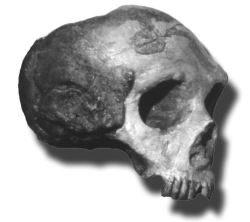Big-eye brain-less Neandertal nonsense

BBC News opened their story on this with: “A study of Neanderthal skulls suggests that they became extinct because they had larger eyes than our species.”1
This outlandish claim arose out of a paper published in the esteemed Proceedings of the Royal Society B.2 Researchers reported that they compared the skulls of 32 Homo sapiens and 13 Neandertals. The latter had larger eye sockets—by an average of 6 mm (1/4 inch) from top to bottom. The researchers said this meant that more of the Neandertal brain would have been dedicated to vision, “leaving less brain to deal with other functions like social networking”.
Huh? Neandertals had slightly bigger eye sockets so they used more of their brains for visual processing and therefore were not as bright as ‘modern’ humans who therefore outcompeted them thanks to superior social networking and that’s why the Neandertals went extinct! And they call this ‘science’?

But they’re serious: “We infer that Neanderthals had a smaller cognitive part of the brain and this would have limited them, including their ability to form larger groups. If you live in a larger group, you need a larger brain in order to process all those extra relationships,” said one of the researchers, Professor Chris Stringer, of London’s Natural History Museum (and of ‘Boxgrove Man’3,4 fame).
He went on to say that this might have given us a crucial survival advantage. “Even if you had a small percent better ability to react quickly, to rely on your neighbours to help you survive and to pass on information—all these things together gave the edge to Homo sapiens over Neanderthals, and that may have made a difference to survival.”
But the ‘reasoning’ is hugely flawed, in the light of:
- Bigger eye sockets does not necessarily mean more light sensors/optic nerve fibres, so more of the brain would not be used.
- Neandertals had significantly bigger brains than ‘modern’ humans to start with, on average, anyway, so if more was used for visual processing, there would still be probably as much left as a ‘modern human’.
- The human brain is incredibly plastic in its organization, which cannot be ascertained by measuring eye sockets. For example, scientists have
studied a girl born in Germany without the right hemisphere of her brain who can see normally. The optic nerves from her left and right eyes that would normally go to her right
hemisphere re-routed to the left-hemisphere where regions of the brain were allocated to accommodate her vision. Dr Lars Muckli, who led the University of Glasgow study,
said:
“This study has revealed the surprising flexibility of the brain when it comes to self-organising mechanisms for forming visual maps.
“The brain has amazing plasticity but we were quite astonished to see just how well the single hemisphere of the brain in this girl has adapted to compensate for the missing half.
“Despite lacking one hemisphere, the girl has normal psychological function and is perfectly capable of living a normal and fulfilling life. She is witty, charming and intelligent.”5
So much for the wild conclusions that Neandertals has less brain available for social functions because their eyes were slightly bigger!
Furthermore, these claims by Stringer and his colleagues run counter to an ever-increasing number of studies for well over a decade now pointing to Neandertals being just as intelligent as humans today, i.e. just like ‘modern humans’.6,7
Consider, for example, the recent report of medicinal chemicals being found in the tartar on Neanderthal teeth.8 The chemicals were from bitter herbs with “no nutritional qualities—but known medicinal qualities”, e.g. yarrow (an astringent) and camomile (an anti-inflammatory). New Scientist reported, by way of introduction: “Call it the Neanderthal health service”.2
Study after study of Neandertals point to their humanity. This is consistent with them being one of the post-Flood populations of humans that descended from Noah and his family, following the dispersion from Babel (Genesis 11).
References
- Neanderthals’ large eyes ‘caused their demise’, BBC News, http://www.bbc.co.uk/news/science-environment-21759233, 13 March 2013. Return to text.
- Pearce, E., Stringer, C. and Dunbar, R., New insights into differences in brain organization between Neanderthals and anatomically modern humans, Proceedings of the Royal Society B, 280(1758): 20130168, 7 May 2013. Return to text.
- ‘Boxgrove man’ … tall and human, Creation 16(4): 9, 1994, creation.com/focus-164#boxgrove-man. Return to text.
- Batten, D., Not another ape-man! Creation 18(3):42–45, 1996, creation.com/not-another-ape-man. Return to text.
- Scientists reveal secret of girl with ‘all seeing eye’; http://phys.org/news167324813.html, July 20, 2009. Return to text.
- Oard, M., Neandertal man—the changing picture, Creation 25(4):10–14, 2003; creation.com/neandertal. Return to text.
- Terborg, P. and Truman, R., The FOX2P gene supports Neandertals being fully human, Journal of Creation 22(2):13–14, 2008. Return to text.
- Neanderthals had herbal know-how, New Scientist 215(2875):14, 28 July 2012. Return to text.



Readers’ comments
Comments are automatically closed 14 days after publication.